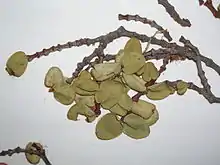Euphorbia kuwaleana
Euphorbia kuwaleana (syn. Chamaesyce kuwaleana)[2] is a rare species of flowering plant in the euphorb family known by the common name kokomalei. It is endemic to Oahu, Hawaii, where it is known only from a four-kilometer stretch of the Waianae Range.[1] Like other Hawaiian euphorbs, this plant is known locally as `akoko. It is a federally listed endangered species of the United States.
| Euphorbia kuwaleana | |
|---|---|
 | |
| herbarium specimen | |
| Scientific classification | |
| Kingdom: | Plantae |
| Clade: | Tracheophytes |
| Clade: | Angiosperms |
| Clade: | Eudicots |
| Clade: | Rosids |
| Order: | Malpighiales |
| Family: | Euphorbiaceae |
| Genus: | Euphorbia |
| Species: | E. kuwaleana |
| Binomial name | |
| Euphorbia kuwaleana O. Deg. & Sherff | |
| Synonyms | |
|
Chamaesyce kuwaleana | |
This is a shrub that grows on bare, exposed basalt cliffs. The stems grow to a maximum length approaching one meter and they contain a milky sap. The new stems are reddish in color and age to a waxy gray. The leaves are oval to heart-shaped, up to 2.5 centimeters long, and slightly hairy on the undersides. The inflorescence is a cyathium occurring singly in the leaf axils or at the tip of the stem.
There are about 2000 plants remaining.[1] They are threatened by non-native plants and fire.[1]
| Wikimedia Commons has media related to Euphorbia kuwaleana. |
References
- The Nature Conservancy
- "Euphorbia kuwaleana". Germplasm Resources Information Network (GRIN). Agricultural Research Service (ARS), United States Department of Agriculture (USDA). Retrieved 23 January 2018.
